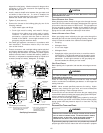
33
• Circulator blower is energized on the appropriate cool speed
at the level and time determined by the selected ramping
profile. Electronic air cleaner terminals are energized with
circulator blower.
• Furnace circulator blower and outdoor cooling unit run their
appropriate speed, integrated control module monitors
safety circuits continuously.
• R and YLO/G or Y/G thermostat contacts open, completing
the call for cool.
• Outdoor fan and compressor are de-energized.
• Circulator blower continues running during a cool off delay
period. The OFF delay time and airflow level are determined
by the selected ramping profile.
• Electronic air cleaner terminals and circulator blower are
de-energized.
• Furnace awaits next call from thermostat.
FAN ONLY MODE
The normal operational sequence in fan only mode is as follows:
• R and G thermostat contacts close, initiating a call for fan.
• Integrated control module performs safety circuit checks.
• Circulator blower is energized on continuous fan speed
(56% of high stage cooling) following a five (5) second delay.
Electronic air cleaner terminals are energized.
• Circulator blower runs, integrated control module monitors
safety circuits continuously.
• R and G thermostat contacts open, completing the call for
fan.
• Circulator blower is de-energized. Electronic air cleaner
terminals are de-energized.
• Furnace awaits next call from thermostat.
XVI. OPERAXVI. OPERA
XVI. OPERAXVI. OPERA
XVI. OPERA
TITI
TITI
TI
OO
OO
O
NAL CHECKNAL CHECK
NAL CHECKNAL CHECK
NAL CHECK
SS
SS
S
BURNER FLAME
The burner flames should be inspected with the burner compart-
ment door installed. A sight glass is provided for inspection pur-
poses. Flames should stable, quiet, soft, and blue (dust may
cause orange tips but they must not be yellow). Flames should
extend directly outward from the burners without curling, floating, or
lifting off. Flames must not impinge on the sides of the heat ex-
changer firing tubes.
Check the burner flames for:
1. Good adjustment
2. Stable, soft and blue
3. Not curling, floating, or lifting off.
Burner Flame
XVII. SAFETY CIRCUIT DESCRIPTIONXVII. SAFETY CIRCUIT DESCRIPTION
XVII. SAFETY CIRCUIT DESCRIPTIONXVII. SAFETY CIRCUIT DESCRIPTION
XVII. SAFETY CIRCUIT DESCRIPTION
GENERAL
A number of safety circuits are employed to ensure safe and proper
furnace operation. These circuits serve to control any potential
safety hazards and serve as inputs in the monitoring and diagno-
sis of abnormal function. These circuits are continuously moni-
tored during furnace operation by the integrated control module.
INTEGRATED C ONTROL M ODULE
The integrated control module is an electronic device which, if a
potential safety concern is detected, will take the necessary pre-
cautions and provide diagnostic information through an LED.
PRIMARY LIMIT
The primary limit control is located on the partition panel and moni-
tors heat exchanger compartment temperatures. It is a normally-
closed (electrically), automatic reset, temperature-activated sen-
sor. The limit guards against the overheating as a result of insuffi-
cient conditioned air passing over the heat exchanger.
AUXILIARY L IMIT
The auxiliary limit controls are located on or near the circulator
blower and monitors blower compartment temperatures. They are
a normally-closed (electrically), manual-reset sensors. These lim-
its guard against overheating as a result of insufficient conditioned
air passing over the heat exchanger.
ROLLOUT L IMIT
The rollout limit controls are mounted on the burner/manifold as-
sembly and monitor the burner flame. They are normally-closed
(electrically), manual-reset sensors. These limits guard against
burner flames not being properly drawn into the heat exchanger.
PRESSURE SWITCHES
The pressure switches are normally-open (closed during opera-
tion) negative air pressure-activated switches. They monitor the
airflow (combustion air and flue products) through the heat ex-
changer via pressure taps located on the induced draft blower and
the coil front cover. These switches guard against insufficient air-
flow (combustion air and flue products) through the heat exchanger
and/or blocked condensate drain conditions.
FLAME SENSOR
The flame sensor is a probe mounted to the burner/manifold as-
sembly which uses the principle of flame rectification to determine
the presence or absence of flame.
XVIII. TROUBLESHOOTINGXVIII. TROUBLESHOOTING
XVIII. TROUBLESHOOTINGXVIII. TROUBLESHOOTING
XVIII. TROUBLESHOOTING
ELECTROSTATIC DISCHARGE (ESD) PRECAUTIONS
NOTE: Discharge body’s static electricity before touching unit. An
electrostatic discharge can adversely affect electrical components.
Use the following precautions during furnace installation and ser-
vicing to protect the integrated control module from damage. By
putting the furnace, the control, and the person at the same electro-
static potential, these steps will help avoid exposing the integrated
control module to electrostatic discharge. This procedure is appli-
cable to both installed and uninstalled (ungrounded) furnaces.
1. Disconnect all power to the furnace. Do not touch the
integrated control module or any wire connected to the control
prior to discharging your body’s electrostatic charge to
ground.
2. Firmly touch a clean, unpainted, metal surface of the
furnaces near the control. Any tools held in a person’s
hand during grounding will be discharged.
3. Service integrated control module or connecting wiring
following the discharge process in step 2. Use caution not
to recharge your body with static electricity; (i.e., do not move
or shuffle your feet, do not touch ungrounded objects, etc.).
If you come in contact with an ungrounded object, repeat


















